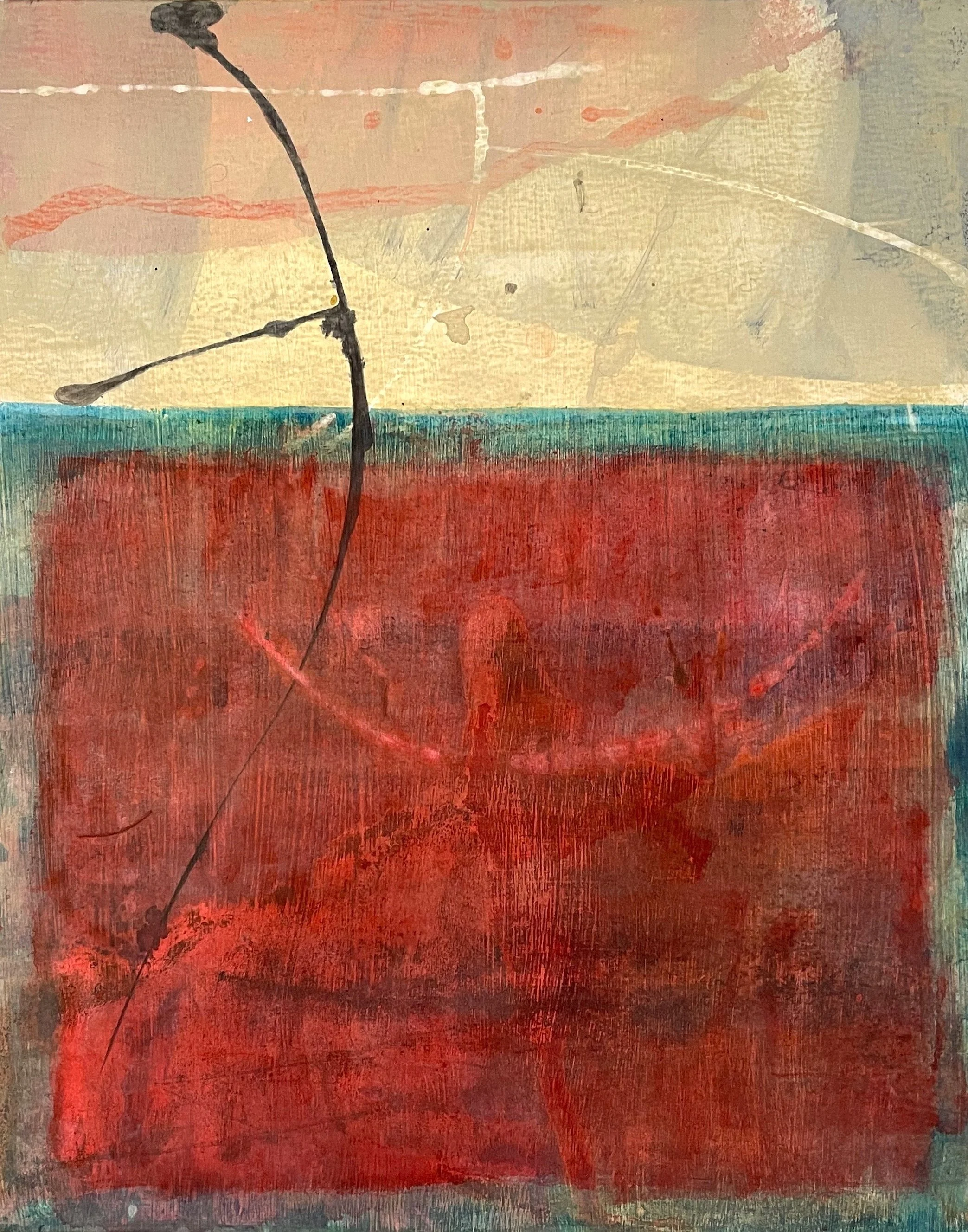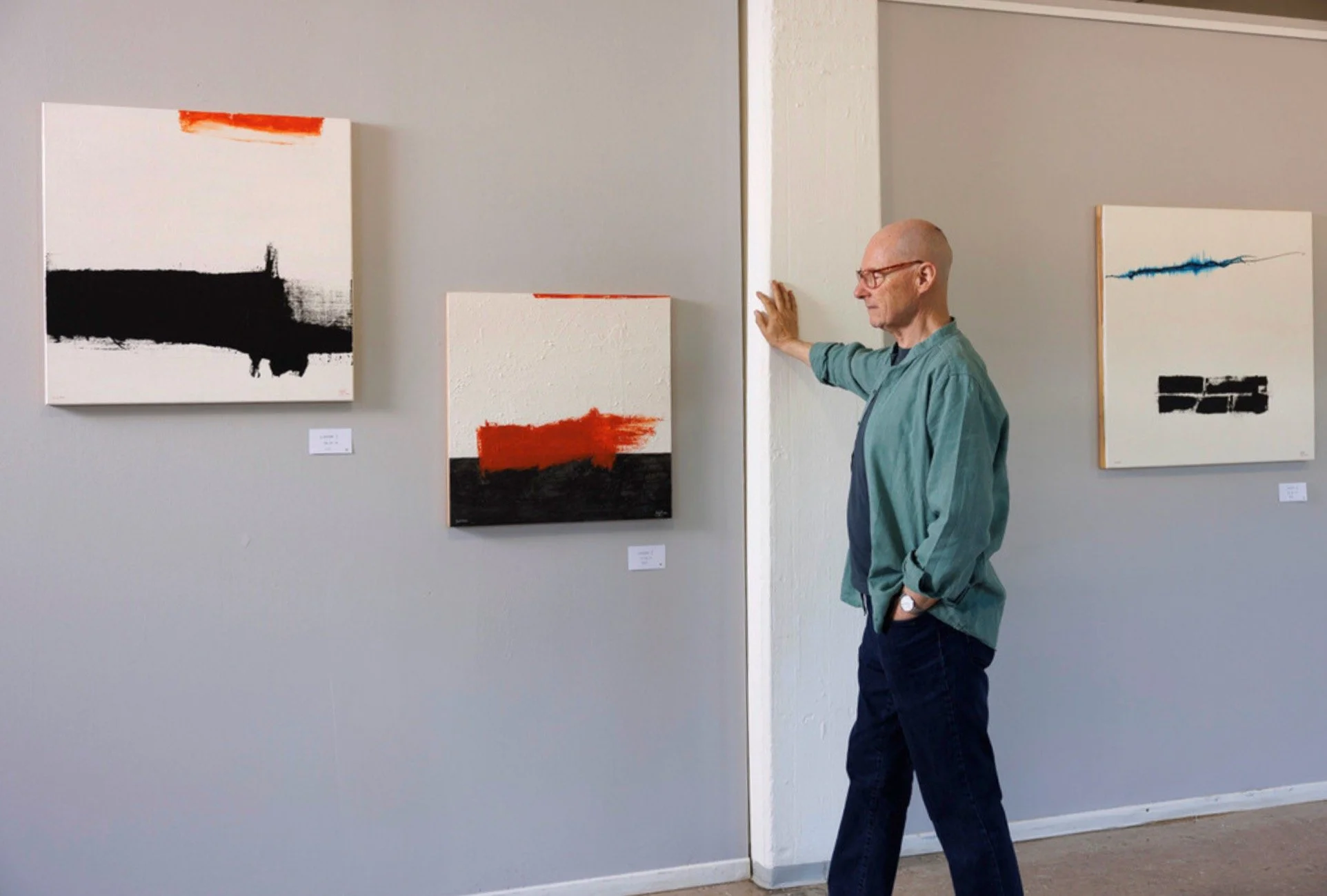Interview
David Drain
David Drain is a Scottish visual artist, living in the South of Germany close to the Swiss border and the art city Basel. David studied Engineering at University in Glasgow and subsequently worked across the globe as project engineer, including several years in the Ukraine. In the final years of his professional life, David worked in the pharmaceutical industry in Basel, Switzerland. As a teenager, he was keen on studying art at one of the Glasgow art schools. That for many reasons did not happen. In 2016, he decided to reinvent himself and plunged into full time artmaking. His studio is in the same building as his home. Studio visits are most welcome, by appointment. David exhibits regularly across Europe in solo and group exhibitions. A large percentage of the sales from David Drain’s artworks continues to go to humanitarian charities.
What is your background and how did you start your journey in the art world?
“As a teenager, in my home in Scotland, I dearly wanted to go to art school and immerse myself in art, and become an artist. That did not happen, for various reasons. Instead, I studied engineering at University in Glasgow. And I subsequently worked globally as a project engineer, in many fascinating locations, including several years spent in the Ukraine. The final years of my professional life, prior to artmaking, were in the pharmaceutical industry in Basel, Switzerland. I have lived for many years now in a village the South of Germany close to the Swiss border and the beautiful art city Basel. In 2016, I took the decision to dedicate my passion and energy to working full time as an artist, creating abstract works.”
What inspires you?
“One of my main sources of inspiration is simple play. I work on the floor almost exclusively in my studio. I need to be able to move a lot when I paint. And I just take large pieces from my canvas roll, or paper roll, or a birchwood boards, lay them side by side on the floor, and I get started. I just fool around; no intention, no plan, no expected outcome. All of my necessary materials and tools are within easy reach, paint, utensils, scrapers, rollers, acrylics, inks, sandpaper, are all within easy reach. Coffee and chocolate are almost always also at hand. Having no expected outcome often reveals new interactions, new subtle possibilities and combinations. The sea inspires me. Growing up in Scotland is such that you are never really far from the sea. The vastness of the sea, the horizon and infinite permutations of light will continue to inspire my abstract artworks. And there are moments where I discover wonderful images almost by accident, which intrigue me and inspire me. Recently, drinking coffee with friends in Basel, I noticed the patterns on the stone floor, the natural lines of imperfection in the stone at this particular street café. That had an impact.”
What themes do you pursue? Is there an underlying message in your work?
“‘Imperfect as Essential’ is one of my main themes. I strive to capture a high degree of subtlety and mystery in my abstract paintings. This creative challenge nourishes me and satisfies me on many levels, occasionally driving me slightly crazy! My paintings are a balancing act, a dynamic tension between the raw and the refined, between play, chance and decision. Imperfection is an important theme for me. Imperfection plays a major role in the creation of my artworks. I want the viewer to see, or better to feel, the history, the struggle, in the multitude of layers in each painting, if you will. This corresponds to authenticity for me, this is an expression of my authenticity as an artist. Imperfection is as essential in contemporary art as it is in life itself!”
How would you describe your work?
“My works identify increasingly with minimalism and reduction. I create only abstract paintings. There are no representational elements involved, no recognisable things to see. That allows me a huge degree of freedom. For me, abstract art is a language in itself. And I find myself increasingly at home in this language of abstraction. I’m working on enhancing the impact of my paintings by reducing the elements involved and the also reducing the complexity. I often use for example large fields of single nuanced colour combined with forms, textures, shapes, line, to create impact. The old adage of less is more is to a degree my guideline here. An example of this is my recent LANARK series.”
Which artists influence you most?
“Paul Klee, Wassily Kandinsky, Mark Rothko, Kasimir Malewitsch, Agnes Martin, to name just a few. I have a reverence for each of these artists. They have created artworks which continue to have a powerful impact on my creative process. By that I mean in terms of what I consider to be important, or even essential in my abstract work. Each of these artists has paved the way and shown us how abstraction goes far beyond words.”
“Creating abstract artworks has become a natural language for me, a means of expression, a way of revealing fine layers of meaning, of mystery held within form and texture, line and hue.”
What is your creative process like?
“Hemingway is quoted as having said ‘Write drunk, edit sober.’ This is also often the case of what goes on in my work. I don’t paint drunk; I don’t drink when painting. I paint playfully, sometimes even recklessly. Then I edit. I usually work on a series of three, or five, or seven paintings together. That makes it much easier not to get stuck or too focused on any one painting. This works for me. And I paint on the floor. I have a large studio with lots of floor space. I never paint conventionally using an easel and brushes. In fact, I hardly ever use brushes. I have, in play mode, many useful tools for working with in creating my abstract paintings. These tools are all within easy reach and I enjoy working on the floor because it allows me to move around a lot, which also lessens the risk of getting stuck with any one particular painting. At times I have a specific idea, a concept, an intention at the front of my mind while painting. At other times I am on a wave of emotion, working through a memory, an experience, an imagined scene in my inner eye. And I play, edit, play again, until I feel at one with what is emerging, what I have created in each particular series. Creating abstract artworks has become a natural language for me, a means of expression, a way of revealing fine layers of meaning, of mystery held within form and texture, line and hue. In making my paintings, I find my way, exploring, searching, discovering, playing, reducing, refining, distilling; always with the intention of an unfolding sense of meaning in what emerges, in what I experience as intriguing and compelling. By employing materials such as marble paste, charcoal, ink, paper, and sand on wood panel and canvas, my paintings capture the whispers of nature, the patina of time, and the subtlety of emotions. My artworks are an interplay between the raw and the refined. They are light and ethereal, yet grounded.”
What is an artist’s role in society and how do you see that evolving?
“I see the role of the artist in today’s world as that of a form of lightning conductor. What do I mean by that? Both we as individuals and as society can reach to art as a means of finding reflection, finding expression for our emotions. And this both in looking at art and in creating art. My belief in the critical importance of art has grown exponentially. Art is becoming more and more a means of balancing in many people’s lives. We think of the old adage, that art has a healing influence. Speaking personally, as an established artist, I experience the pleasure and even comfort which collectors of my artworks experience.”
Have you had any noteworthy exhibitions you'd like to share?
“I currently have a major solo exhibition running at the Culture Factory in Schopfheim, in the South of, Germany. This exhibition is hosted by the Art Society and is in a large and beautiful space. I have 71 paintings on show. And the exhibitions started on 25 May and runs until 6 July 2025. I am giving two Artist Talks, 4 June and 22 June. This year, I also exhibited in a group show at the Van Gogh Art Gallery in Madrid. I will be showing at the following art fairs this year: Art World Fair Paris, November 2025 and Red Dot Art Fair Miami, December 2025. My first solo exhibition was in Basel, Switzerland in 2017 and since then I have been exhibiting regularly in major locations across Europe. Note that I continue to donate a large percentage of all earnings from the sale of my artworks to humanitarian charities.”

















